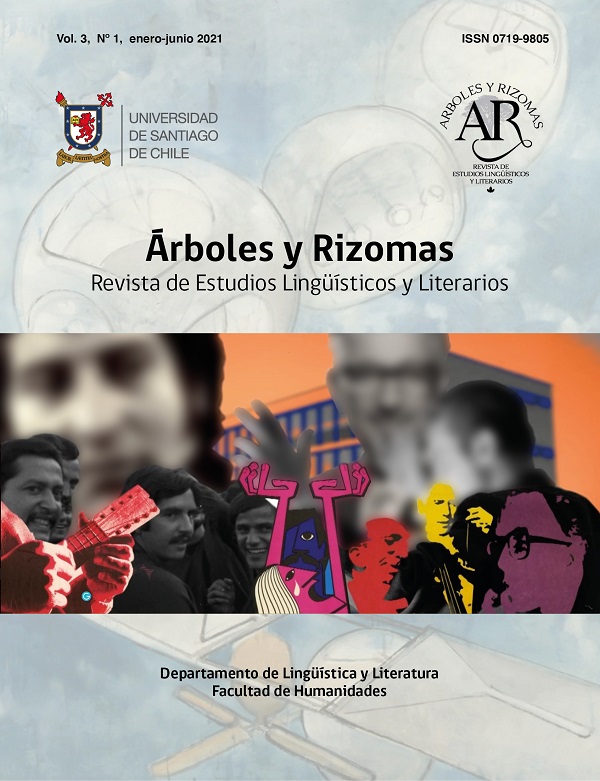Literature and visual memory: Aesthetic-performative chains between the narratives of memory and the October 2019 Social Uprising
DOI:
https://doi.org/10.35588/ayr.v3i1.4937Keywords:
city, protest, literature, ruin, photographyAbstract
The so-called Social Uprising, which took place between October and December 2019 in Chile, highlighted the importance of the urban counter-narratives operating in contexts of social struggle and protest (Márquez and Rozas, 2019). Understood as scratches, banners and artistic performances, the counter-narratives represent a resignification of the urban space that consider the city as discourse (Rama, 1998) and present a homogeneous image of identity based on the monument (Harvey, 1990). Addressing that discourse implies an aesthetic-performative relation with the literary narratives of memory that are set from the 1990s onwards, where the articulation of counter-spaces (Locane, 2013) also assumes an act of resignification of the space. In that way, this article is a comparison between the visual record of the Social Uprising and its aesthetic chains to the literature of memory. By reading and analyzing authors such as Bisama (Taxidermia, 2014), Celedón (La Filial, 2012), Sutherland (Papelucho gay en dictadura, 2019) and Fernández (Fuenzalida, 2012; Chilean Electric, 2015), we can see those traces of ruin, photography and artistic performance set in tension the hegemonic signs in the urban design, highlighting the problems of memory and identity of those who experience the city.
Downloads
References
Alvarado, M. (1994). Paratexto. Buenos Aires: UBA.
Amaro, L. (2013). Formas de salir de casa, o cómo escapar del Ogro: relatos de filiación en la literatura chilena reciente. Literatura y Lingüística (29), 109-129. http://dx.doi.org/10.4067/S0716-58112014000100007
Anabalon, N. (2016). Escribir después del desastre: recuerdo y testimonio en Estrellas Muertas de Álvaro Bisama. Revista Catedral Tomada vol. 4 (6), 91-103.
Bajtín, M. (2011). Las fronteras del discurso. Borovsky, Luisa (trad). Buenos Aires: Las Cuarenta.
Barthes, R. (1989) La cámara lúcida: notas sobre la fotografía. Sala-Sanahuja, J. (trad.). Buenos Aires: Ed. Paidós, 2017.
Bisama, A. (2014). Taxidermia. Santiago: Alquimia Editores.
Bongers, W. (2018). Memoria, medios audiovisuales y literatura expandida en la narrativa chilena reciente (Baradit, Fernández, Zambra). Revista de Humanidades (37), 103-130.
Celedón, M. (2012). La Filial. Santiago de Chile: Alquimia Editores.
Cisternas, C. (2010). Introducción. Imagen de la ciudad en la literatura hispanoamericana y chilena contemporánea. Santiago: Editorial Universitaria.
Didi-Huberman, G. (2004). Imágenes pese a todo: Memoria visual del Holocausto. Barcelona: Ediciones Paidós Ibérica.
Echeverría, L., Rebolledo, J. y Tótoro, D. (2019). Hasta que valga la pena vivir. La revolución de octubre de 2019 en los muros de Santiago. Santiago: Ceibo Editores.
Fernández, N. (2012). Fuenzalida. Santiago de Chile: Ed. Random House Mondadori.
_____ (2015) Chilean Electric. Santiago: Alquimia Editores.
Fernández Droguett, R. (2019). Marchas y conmemoraciones. Santiago y el centro histórico. En Márquez, F. (ed.) Patrimonio: Contranarrativas urbanas (pp. 115-130). Santiago de Chile: Ediciones Universidad Alberto Hurtado.
Franz, C. (2001). La muralla enterrada. Santiago: Editorial Planeta.
Harvey, D. (1990). La condición de la posmodernidad: Investigación sobre los orígenes del cambio cultural. Eguía, M. (trad.). Buenos Aires: Amorrortu Editores, 1998.
Jeftanovic, A. (2007). Mapocho de Nona Fernández: La ciudad entre la colonización y la globalización. Chasqui: Revista de literatura latinoamericana (36), 73-84.
Kropotkin, P. (2014). La moral anarquista. Santiago de Chile: Ediciones Espartaco.
Locane, J. (2013). Ciudad y literatura. Apuntes para un modelo de abordaje de las ciudades textuales fundado en la teoría de Henri Lefebvre. Estudios de Teoría Literaria año 2 (4), 111-124.
Márquez, F. y Rozas, V. (2019). Las heridas de la memoria. Palacio de la Moneda. En Márquez, F. (ed.) Patrimonio: Contranarrativas urbanas (pp. 37-52). Santiago de Chile: Ediciones Universidad Alberto Hurtado.
_____ (2019). Ocupación y reclamo. Universidad de Chile. En Márquez, F. (ed.) Patrimonio: Contranarrativas urbanas (pp. 53-74). Santiago de Chile: Ediciones Universidad Alberto Hurtado.
Márquez, F. (2020) Por una antropología de los escombros. El estallido social en Plaza Dignidad, Santiago de Chile. Revista 180, 45. (1-13).
http://dx.doi.org/1032995/rev180.Num-45.(2020)art-717
Mitchell, W.J.T. (2009). Teoría de la Imagen. España, Madrid: Akal.
Rama, A. (1998). La ciudad letrada. Montevideo: Arca.
Reyes Gil, S. (2020) Corte y conceptualismo en La Filial (2013) de Matías Celedón. Revista Letral (24), 139-158.
Richard, N. (2000). Imagen-recuerdo y borraduras. Richard, N. (ed.) Políticas y estéticas de la memoria (pp. 165-172). Santiago de Chile: Editorial Cuarto Propio.
_____ (2001). Residuos y Metáforas (Ensayos de crítica cultural sobre el Chile de la Transición). Santiago de Chile: Editorial Cuarto Propio.
_____ (2018). La contorsión-subversión travesti. Abismos temporales. Feminismo, estéticas travestis y teoría queer (pp. 41-55). Santiago de Chile: Ed. Metales Pesados.
Salomón, J. (2013). Identidad queer en la obra de Juan Pablo Sutherland. Revista Nomadías, (18), 67-84.
Segato, R. (2013). La escritura en el cuerpo de las mujeres asesinadas en Ciudad Juárez. Territorio, soberanía y crímenes de segundo estado. Buenos Aires: Tinta Limón Ediciones.
Sutherland, J. P. (2019). Papelucho gay en dictadura. Santiago de Chile: Alquimia Editores.
Todorov, T. (2008). Los abusos de la memoria. España, Barcelona: Ed. Paidós.
Trabuco Zerán, A. (2015). La Resta. Santiago de Chile: Tajamar Editores.
Vargas, J. (2019). Iluminar con la letra la temible oscuridad: Espacio y visualidad en la narrativa de Nona Fernández. Tesis para optar al grado de Magíster en Literatura Latinoamericana y Chilena, USACH.
Williams, R. (2000). Marxismo y Literatura. Barcelona: Ediciones Península.






